Rheological properties of chocolate
- Like
- Digg
- Del
- Tumblr
- VKontakte
- Buffer
- Love This
- Odnoklassniki
- Meneame
- Blogger
- Amazon
- Yahoo Mail
- Gmail
- AOL
- Newsvine
- HackerNews
- Evernote
- MySpace
- Mail.ru
- Viadeo
- Line
- Comments
- Yummly
- SMS
- Viber
- Telegram
- Subscribe
- Skype
- Facebook Messenger
- Kakao
- LiveJournal
- Yammer
- Edgar
- Fintel
- Mix
- Instapaper
- Copy Link
Posted: 13 May 2011 | Bettina Wolf, Division of Food Sciences, School of Biosciences, University of Nottingham | 2 comments
Chocolate is a multiphase confectionary product which is consumed as a treat or in-between meals to overcome hunger. The popularity of chocolate is almost certainly due to its unique eating characteristics. It melts in the mouth, imparting a sensation of cooling. The surfaces of the oral cavity are coated by the melted chocolate and flavour is released. The intensity of each of the associated sensory attributes depends largely on the characteristics of the chocolate determined by type and concentration of the ingredients and the manufacturing process. The rheological properties of chocolate in its molten state (short referred to as chocolate in the following) are important to the eating quality and processing of chocolate.
As for any structured product, the rheological properties of chocolate are closely related to its microstructure which is imparted by choice of ingredients and manufacturing process. The continuous phase of chocolate is composed of cocoa butter with added emulsifier (lecithin or polyglycerol polyricinoleate) in the order of one gram / 100 grams. A small fraction of the cocoa butter may be replaced by other milk fat or other fats. Emulsifier presence is important to ensure dispersion of the crystalline sugar which may be present at levels of ≈ 50 grams / 100 grams. A plain dark chocolate would also contain cocoa solids and a milk chocolate has an additional fraction of milk solids, often in the form of skim milk powder. Thus, molten chocolate represents a complex suspension with at least two dispersed solid phases. The system is highly filled. For example, the particle phase volume of a chocolate containing fat at 30 grams / 100 grams is 0.57. Particle size is adjusted to below ≈ 25 microns to avoid grittiness but there is a lower limit as size reduction causes viscosity increase.
In this contribution, recommended measurement method and some published work on the rheology behaviour of chocolate is reviewed. However, the aim of the article is not to be a thorough review but to introduce the topic and factors influencing chocolate rheology.
Shear viscosity measurement of molten chocolate
Shear viscosity of chocolate for quality control purposes tends to be measured at 40°C using a rotational rheometer fitted with concentric cylinder geometry. There exists a recommended procedure by the International Office of Cocoa1: (1) Increase of shear rate from 2 to 50 s-1 in three minutes; (2) maintain 50 s-1 for one minute; (3) decrease of shear rate to 2 s-1 in three minutes. A pre-shear protocol of five minutes at 5 s-1 is recommended to be applied before starting the test to acquire the viscosity data (Figure 1).
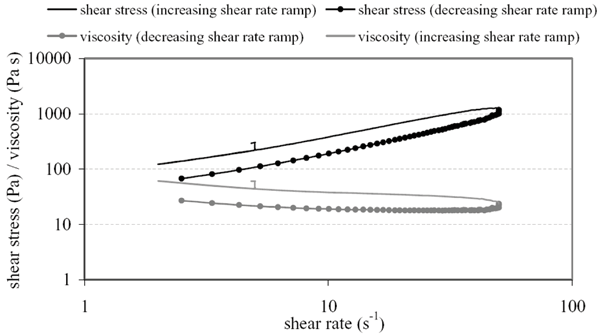

Figure 1 Flow and viscosity curve of a dark chocolate with a fat level of 25 g / 100 g and stabilised with lecithin measured following the IOC recommendation. Pre-shear data are included in the graph (see data at 5 s-1). The area between the data of the increasing shear rate ramp and the decreasing shear rate ramp is referred to as the hysteresis area and gives an indication about the time dependency of the viscosity behaviour of a chocolate. Graph reproduced from Do et al. (2007)10 with permission from the publisher.


(1)
The design of this test protocol is the result of numerous measurements in several R&D rheology laboratories and reading of a paper by Servais et al2 is recommended for details and references. The method then recommends reporting the shear stress measured at 5 s-1 as yield stress and the viscosity measured at 40 s-1 as the apparent viscosity, both taken during shear rate increase. Yield stress and viscosity are meaningful parameters for processes such as enrobing of pralines or manufacture of hollow chocolate figures and pumping, respectively. The yield stress (at 5 s-1s), YS5, and the apparent viscosity, η40, have been reported to be strongly correlated: YS5= 9.3 * η40 (R2 = 0.96). This may be specific to the chocolates evaluated to test this relationship as well as a characteristic of the data determination method. Others have reported no relationship between these two parameters, for example Mongia and Ziegler3 who used the Casson regression method. The IOC previously recommended use of the Casson model (Equation 1) to obtain the Casson yield stress and the Casson plastic viscosity4. However, use of the Casson model has proved to lead to poor reproducibility of data and has therefore been replaced2. Apart from the measurement protocol and data analysis, sample preparation is crucial to obtaining reliable results. For chocolate, this entails melting of the sample in a temperature controlled cabinet or other suitable equipment at an appropriate temperature, mostly 40 to 50°C, while avoiding moisture entering the sample.
Further comparison of rheological models for characterisation of dark chocolate has for example been published by Afoakwa et al5. Researchers and application laboratories in industry often use other protocols and geometries to evaluate the shear viscosity behaviour of chocolate. A popular tool to be fitted to stress controlled rotational rheometers for evaluation of yield stress behaviour is the vane geometry6-9.
Viscosity behaviour of commercial chocolates evaluated using the IOC method
Figure 2 shows the viscosity curves of four chocolate samples purchased from a local supermarket. The IOC measurement protocol was followed. The two data traces acquired for each chocolate on independently loaded samples demonstrate the good reproducibility of the measurements. It can clearly be seen that the two chocolates shown in part (a) of Figure 2 do not show any hysteresis. This means that the viscosity behaviour is independent of the shear history of the dark chocolate and the chocolate labelled ‘Milk A’ which is a dry mix chocolate. The white chocolate and the other milk chocolate tested, which is a crumb chocolate, show hysteresis, see part (b) of Figure 2. The time dependent behaviour is also evident from the viscosity decrease during the pre-shear period as well as the holding period at maximum shear.


Figure 2: Viscosity behaviour of four commercial chocolate samples measured following the IOC protocol. All results of all four stages of the IOC protocol (pre-shear, increasing shear rate ramp, holding at maximum shear, decreasing shear rate ramp) are plotted. Two measurements were performed on each sample and both traces are shown in all graphs. The samples included Dark Chocolate from Sainsbury’s basics range labelled ‘Dark’, Milka Alpine Milk manufactured by Kraft Foods labelled ‘Milk A’, Cadbury Dairy Milk labelled ‘Milk B’ and White Chocolate from Green & Black’s Organic range labelled ‘White’.
Factors influencing the rheological behaviour of chocolate
The characteristics and level of both the fat phase including the emulsifier(s) and the solids phase together with the changes they undergo during processing have a large impact on the flow characteristics of a chocolate. Reasons to alter the composition of a chocolate formulation may be for technological, consumer acceptance or nutritional reasons. Introduction of cheaper, more natural and sustainable ingredients as well as those improving the nutritional balance of chocolate to, for example, achieve fat and sugar reduction, are amongst the objectives. Most rheological investigations on chocolate have been undertaken on dry mix chocolate. Reports on crumb chocolate are scarce but the differences in the production process are most often not only reflected in the flavour characteristics of the products but also in the viscosity behaviour. In brief, in the crumb process, sugar, milk powder and cocoa mass are pre-processed to a paste followed by drying and milling and used as such as a chocolate ingredient. In the dry mix process, sugar, milk powder and cocoa solids are mixed directly with the fat phase.
Dry mix chocolate: particle size distribution
The effect of particles size distribution evaluated on the solid sugar phase has been reported by Do et al10. The introduction of a fraction of large sugar particles enabled removal of fat from the formulation while retaining the apparent viscosity of the full fat formulation containing only small sugar particles (Figure 3). This approach for the manufacture of fat reduced chocolate satisfies the rheology condition but has the flaw that this product tastes such that and alternative non-gritty large particles need to be identified.
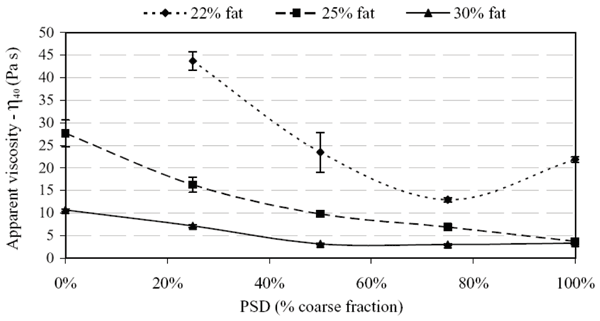

Figure 3 Impact of particle size distribution (PSD) expressed as percentage of the coarse fraction and fat content on apparent viscosity of a dark chocolate measured at 40°C. The characteristic particle diameter of the fine fraction was 15 μm and 27 μm expressed as d43 and d90,3, respectively. Corresponding values for the coarse fraction were d43 = 50 μm and d90,3 = 107 μm. Graph reproduced from Do et al. (2007)10 with permission from the publisher.
Cocoa solids
The characteristics of the cocoa solids phase also affect chocolate rheology11. In addition to particle size and shape, different cocoa solids may vary with regard to their internal and external (surface) morphology – all parameters known to affect the flow behaviour of suspensions. The matter of trapped fat was also discussed, which is typically only considered for the milk solids.
Milk solids
It is one of the physical characteristics of milk powder that it contains trapped fat. The level of trapped fat counts towards the fat content of chocolate but this part of the fat does not contribute to the flowability of the chocolate. Therefore, high levels of trapped fat tend not to be desirable and papers on the relationship between trapped fat content, milk powder processing and milk seasonality as factors influencing the flow behaviour of milk chocolate have been published. For example, Attaie et al12 report on the development of spray dried milk powders imparting low viscosity when used in chocolate processing. They demonstrated that level of trapped fat impacted to a larger extent on chocolate viscosity for spray dried milk powders compared to a roller dried milk powder (Figure 4). Liang and Hartel13 also mentioned the preference of using roller dried milk powder over spray dried milk powder for the manufacture of chocolate. Free fat content of spray dried milk powder may vary as a result of seasonal variation in the milk14.
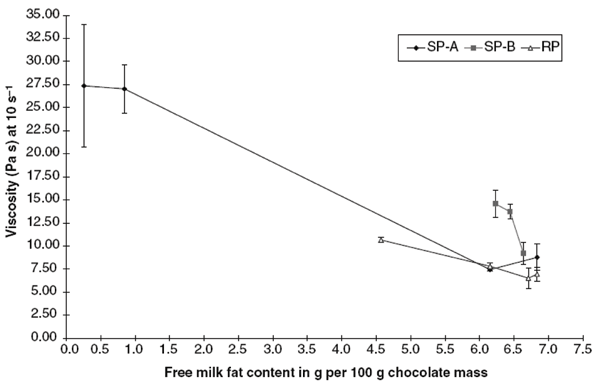

Figure 4 Viscosity measured at 10 s-1 and at 40°C for milk chocolates prepared with two types of spray dried milk powder (SP-A and SP-B) or roller dried milk powder (RP). The total milk fat content in these chocolates was between 6.57 g and 7.55 grams / 100 grams chocolate. Graph reproduced from Attaie et al. (2003)12 with permission from the publisher.
Sugar and fat replacement
Sugar replacement in chocolate formulations tends to be targeted at reducing the calorie content of chocolate. Sugar substitutes such as polydextrose and maltodextrin and sucralose have been reported to lead to higher moisture contents in the chocolate depending on level of substitution15. Increased moisture content has a negative impact on chocolate viscosity.
Replacing cocoa butter with an alternative fat may be for cost saving reasons, the levelling of variations in cocoa butter properties depending on supply or to reduce calorie content, etc, as well as to improve the heat resistance of chocolate consumed in warm climates. Again, a fat replacer needs to be chosen carefully so as to not have a negative impact on the rheological characteristics of the chocolate. Kokum (Garcinia indica) is a cocoa butter improver evaluated by Maheshwari and Reddy16 who suggested that this fat could be used at a level of up to five grams / 100 grams chocolate to increase hardness without significant difference in Casson plastic viscosity of milk chocolate and only a slight increase in Casson yield value, both measured at 40°C, while hardness measured at 30°C was increased. Application in dark chocolate was also shown to be feasible.
An example of replacing cocoa butter by a non calorific ‘fat’ was published by Do et al17. Limonene, a low molecular weight hydrophobic compound, was added to dark chocolate formulations while lowering the level of cocoa butter to overcome the necessarily accompanying unacceptable increase in viscosity when lowering the continuous phase content in chocolate. The addition of low quantities of limonene to cocoa butter was shown to lead to a great decrease in the liquid fat viscosity. In terms of application, it is worth noting that this chocolate has an orange flavour.
Emulsifier
Lecithin and PGPR are the two emulsifiers applied in chocolate to control viscosity behaviour. A systematic study on the influence of blends of these two emulsifiers on the rheological properties of chocolate can be found by Schantz and Rohm18. They demonstrated that the yield and viscosity behaviour of chocolate can be tailored by choosing a suitable overall emulsifier concentration and lecithin:PGPR blending ratio (Figure 5).
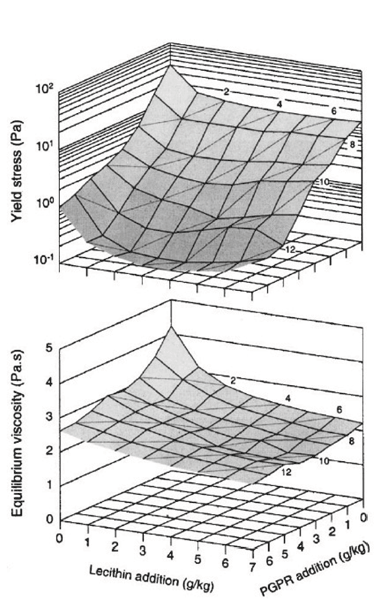

Figure 5 Graphs show yield stress and equilibrium viscosity for dark chocolate as a function of level of lecithin and PGPR. Dotted lines refer to equal total amounts of emulsifier (g/kg), see original publication for rheological method. Graphs reproduced from Schantz and Rohm (2005)18 with permission from the publisher.
Afoakwa et al19 found in a study in which the level of emulsifier (lecithin) was only one of three factors investigated, the other two were particle size distribution and level of fat, that particle size distribution could be manipulated and rheological consequences overcome by a suitable combination of fat and lecithin.
Cooling rate
So far, the focus has been on the role of ingredient properties on the rheological behaviour of chocolate. Baldino et al20 recently reported on rheological properties of chocolate evaluated at conditions close to industrial applications. Using small amplitude oscillatory shear rheology and creep tests relationships between ingredient properties, cooling rate and the rheological behaviour of chocolate are discussed. It was, for example, found that cooling rate had an influence on the dynamic moduli when sugar particle size was decreased.
Crumb chocolate


(2)
Taylor et al21 have reported on the shear rheology of fresh molten chocolate produced from crumb over five decades of shear rate using stress controlled rheometers. These authors applied the Carreau model (Equation 2) to their data and found it gave better correlation to the measurement data in particular at low shear rates (0.1 – 1 s-1) where their chocolates behaved akin to classical granular suspensions. The above already cited paper by Taylor et al21 reports an investigation into the nature of the suspension flow behaviour of chocolate. Careful experimental design allowed the conclusion that the rheological behaviour of chocolate is dominated by hydrodynamic interactions and at solids volume fractions below circa 0.5 the Krieger Dougherty relation described the effect of solids volume fraction accurately. Deviation from predicted behaviour at higher solids volume fractions was attributed to emulsifier action. This paper by Taylor et al21 provides an overview of reported chocolate rheological behaviour at 40°C. The same authors also published oscillatory shear data on chocolate. In shear stress amplitude sweeps a sharp drop in the values of both moduli was observed at the end of the linear viscoelastic regime with the corresponding shear stress value being similar to the equivalent value found in steady shear viscosity measurements. The authors conclude that the elasticity of chocolate at small stresses is not solely due to hydrodynamic interactions between the particles in the chocolate and not due to any other interactions. This finding is rather important in relation to formulation engineering of (crumb) chocolate.
Process rheology
Characterisation of the flow behaviour of chocolate during processing in pipes or extrusion devices has been undertaken by means of a multipass rheometer22, NMR23 and ultrasound velocity profile pressure difference (UVP-PD) technique24. Engmann and Mackley25 have also modelled the rheology and microstructure changes of chocolate during extrusion.
Concluding remarks
The viscosity behaviour of a chocolate is complex and depends on its manufacturing process as well as on the ingredients. Whereas the IOC initiative has most certainly helped to unify characterisation of chocolate viscosity behaviour, the Casson model is still used where it delivers adequate results. Attempts have been made to quantify the flow behaviour of chocolate under processing conditions in the factory. Changes to chocolate during oral processing are equally important and we are currently investigating this.
References
- International Office of Cocoa (IOC) (2000). “Viscosity of Cocoa and Chocolate Products. Analytical Method 46.” Available from CAOBISCO, rue Defacqz 1, B-1000 Bruxelles, Belgium
- Servais, C., H. Ranc and I. D. Roberts (2003). “Determination of chocolate viscosity.” Journal of Texture Studies 34(5-6): 467-497
- Mongia, G. and G. R. Ziegler (2000). “The role of particle size distribution of suspended solids in defining the flow properties of milk chocolate.” International Journal of Food Properties 3(1): 137-147
- Chevalley, J. (1994). Chocolate flow properties. . Industrial Chocolate Manufacture. S. T. Beckett. London, Blackwell Science: 139-155
- Afoakwa, E. O., A. Paterson, M. Fowler and J. Vieira (2009). “Comparison of rheological models for determining dark chocolate viscosity.” International Journal of Food Science and Technology 44(1): 162-167
- Dzuy, N. Q. and D. V. Boger (1985). “Direct yield stress measurement with the vane method.” Journal of Rheology 29(3): 335-347
- Wilson, L. L., R. A. Speers and M. A. Tung (1993). “Yield stress in molten chocolates.” Journal of Texture Studies 24(3): 269-286
- Barnes, H. A. (1999). “The yield stress – a review or ‘pi alpha nu tau alpha rho epsilon iota’ – everything flows?” Journal of Non-Newtonian Fluid Mechanics 81(1-2): 133-178
- Aeschlimann, J. M. and S. T. Beckett (2000). “International inter-laboratory trials to determine the factors affecting the measurement of chocolate viscosity.” Journal of Texture Studies 31(5): 541-576
- Do, T. A. L., J. M. Hargreaves, B. Wolf, J. Hort and J. R. Mitchell (2007). “Impact of particle size distribution on rheological and textural properties of chocolate models with reduced fat content.” Journal of Food Science 72(9): E541-E552
- Do, T. A. L., J. Vieira, J. M. Hargreaves, J. R. Mitchell and B. Wolf (2011). “Structural characteristics of cocoa particles and their effect on the viscosity of reduced fat chocolate.” Food Science and Technology International 44: 1207-1211
- Attaie, H., B. Breitschuh, P. Braun and E. J. Windhab (2003). “The functionality of milk powder and its relationship to chocolate mass processing, in particular the effect of milk powder manufacturing and composition on the physical properties of chocolate masses.” International Journal of Food Science and Technology 38(3): 325-335
- Liang, B. and R. W. Hartel (2004). “Effects of milk powders in milk chocolate.” Journal of Dairy Science 87(1): 20-31
- Twomey, M., M. K. Keogh, B. T. O’Kennedy and D. M. Mulvihill (2002). “Seasonal effects of some milk powder characteristics on the rheology of milk chocolate.” Irish Journal of Agricultural and Food Research 41(1): 105-116
- Abbasi, S. and H. Farzanmehr (2009). “Optimization of the Formulation of Prebiotic Milk Chocolate Based on Rheological Properties.” Food Technology and Biotechnology 47(4): 396-403
- Maheshwari, B. and S. Y. Reddy (2005). “Application of kokum (Garcinia indica) fat as cocoa butter improver in chocolate.” Journal of the Science of Food and Agriculture 85(1): 135-140
- Do, T. A. L., J. Vieira, J. M. Hargreaves, B. Wolf and J. R. Mitchell (2008). “Impact of limonene on the physical properties of reduced fat chocolate.” Journal of the American Oil Chemists Society 85(10): 911-920
- Schantz, B. and H. Rohm (2005). “Influence of lecithin-PGPR blends on the rheological properties of chocolate.” Lwt-Food Science and Technology 38(1): 41-45
- Afoakwa, E. O., A. Paterson and M. Fowler (2008). “Effects of particle size distribution and composition on rheological properties of dark chocolate.” European Food Research and Technology 226(6): 1259-1268
- Baldino, N., D. Gabriele and M. Migliori (2010). “The influence of formulation and cooling rate on the rheological properties of chocolate.” European Food Research and Technology 231(6): 821-828
- Taylor, J., I. Van Damme, M. Johns, A. Routh, and D. Wilson (2009). “Shear Rheology of Molten Crumb Chocolate.” Journal of Food Science, 74 (4): E55–E61
- Engmann, J. and M. R. Mackley (2006). “Semi-solid processing of chocolate and cocoa butter – The experimental correlation of process rheology with microstructure.” Food and Bioproducts Processing 84(C2): 95-101
- Gotz, J., H. Balzer and R. Hinrichs (2005). “Characterisation of the structure and flow behaviour of model chocolate systems by means of NMR and rheology.” Applied Rheology 15(2): 98-111
- Ouriev, B., E. Windhab, P. Braun, Y. Zeng and B. Birkhofer (2003). “Industrial application of ultrasound based in-line rheometry: Visualization of steady shear pipe flow of chocolate suspension in pre-crystallization process.” Review of Scientific Instruments 74(12): 5255-5259
- Engmann, J. and M. R. Mackley (2006). “Semi-solid processing of chocolate and cocoa butter – Modelling rheology and microstructure changes during extrusion.” Food and Bioproducts Processing 84(C2): 102-108
About the Author
Dr Bettina Wolf is a Chemical Engineer by training (Karlsruhe, D) and holds the degree of Doctor in Technical Sciences ETH (Swiss Federal Institute of Technology, CH). Her postgraduate research was on the flow-induced deformation behaviour of emulsion droplets to further understanding of emulsion rheology and processing. This expertise was later translated in industry based research on phase separated biopolymer mixtures of emulsion microstructure to generate structuring agents for foods. Bettina was introduced to chocolate rheology and structuring of chocolate by Professor Erich Windhab, then at the German Institute of Food Technology (D-Quakenbrück). After concluding her PhD study at ETH, Bettina joined Unilever Research in the UK (Colworth House, Bedford) for 9 years before assuming her current position as Associate Professor in Biomaterials Science at the University of Nottingham (Division of Food Sciences). She resumed research activity on chocolate and has since published on physical structuring of reduced fat chocolate and presented on the eating behaviour of chocolate.



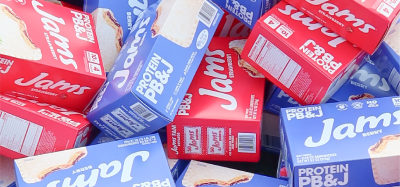


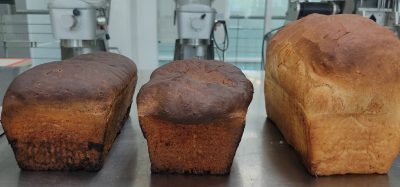


I am teacher at Slovak University of Technology and I am interesting to read some articles in your magazines.
Sincely yours,
Stefan Schmidt
Hi Stefan, you can read this article by registering here. It’s free and will enable you to read this and all the other premium content across the website.